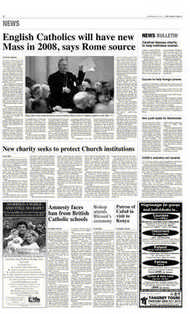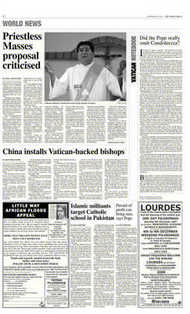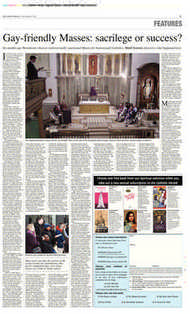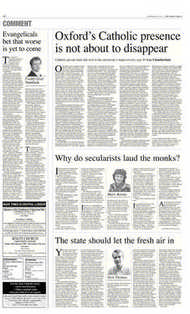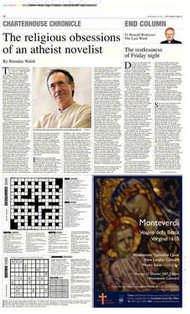Page 12, 28th September 2007
Page 12

Report an error
Noticed an error on this page?If you've noticed an error in this article please click here to report it.
Tags
Share
Related articles
Crowning Triumph
Sensational Art At The Academy
'i Think He Has Always Looked After Me'
Journey Through Time And Canvas
Priests, Prophets, Princesses
Notes For Ransomers
A triumph of terrifying energy
Georg Baselitz
It has happened at last. Or rather, just in time. An exhibition of Georg Baselitz in London is long overdue; however famous he has become in Europe, we have not paid enough attention to this artist in England. The result is a surprise and a sudden challenge. Baselitz is shown to be the most important and original painter since Vincent van Gogh 120 years ago. There is no doubt in my mind that he also overtakes Picasso as the greatest painter of our time in Europe. Comparisons are odious, as we all know, but the vastly spread-out exhibition at the Royal Academy of Baselitz’s enormous pictures confirms the total authority of the artist. We have to thank Sir Norman Rosenthal, the secretary of the Royal Academy, for having achieved such a complete exhibition.
Why is Baselitz so “important” – if one can use such an expression? The plain answer is that he is not important in the usual art history categorisation. Although there are intelligent and well researched essays in the exhibition catalogue (which is very well produced), they do not, ultimately, go to the depth needed to assimilate and understand his unique vision. As luck would have it I was reading the horrifying and truthful diaries of Friedrich Reck-Malleczewen, called Diary of a Man in Despair, billed as “a nonfiction masterpiece about the compre hension of evil”. This diary is a week by week analysis of the endemic and irreversible evils of Nazism from 1935 to 1944. The description of the psychological and spiritual pressure on the German jugular vein, month by month, year by year, as illustrated in this book, cannot be dismissed. It is in the reading of this book that our mind is set towards the stage of the final destruction of Germany in 1943, 1944, and 1945, culminating in the bombing of Dresden, where Baselitz was a child of six. The horrific destruction of so innocent a target has affected the German psyche ever since.
But that was not all. The invasion of eastern Germany, together with the utter destruction of social patterns, religion, economics, personal freedom and the expectation of life, that came with the arrival of Soviet Communism had – and has – a permanent deadly effect on the whole character of German self-assurance.
Something very definite concerning this is described in passages of the book Gentle Regrets by Roger Scruton. In the chapter called “stealing from the Church” he describes the collapse of humanity: on the one side by over-zealous Left-wing certainties of “making the world anew” by destroying the remains of the old, as he saw in post-war Poland, Czechoslovakia and East Germany; while, on the other side, West Germany (like the rest of our Western economy) was faced with the growth of a confident market economy and the reliable managerial society that we all, now, experience daily in the supermarket and on television. It is the total scepticism concerning all these smooth, money-enhancing activities that Baselitz has built into the foundations of his superficially destructive art. But, with this painter, the real presence is that of a resurgent humanity which is indissolubly linked with the soul – within the reality of the body.
It is the horrifying, negative, destructive morass of hopes abandoned, promises unfulfilled and certainties lost that Baselitz has grasped – and, in the quality of his images and the texture of his paint, has done so much to reverse. How is that so? By the destruction of the flesh – in images that are brought about by the very exercise of that same flesh. The sheer muscular energy that supports the gesture of painting is in complete contrast to that smooth, plangent polish of the art of America and the West, influenced by Pop Art and its derivatives – an art that managed to destroy the self-confidence of the whole art scene in postwar Paris by a sort of cultural strangu lation. Certainly since the early 1980s we have not heard of a single French painter, sculptor or architect that has been an internationally recognised authority.
The rejection of non-figuration by Baselitz is attached to the re-assertion of humanity through the illustration of the terrible effects of personal energy in the use of paint. No matter that the message comes over by way of inversion, distortion, destruction and dismemberment. It is, in the end, the message of the Resurrection. Our bodies, our souls, however much dismembered and devoured by infernal circumstances, taken together, in a total unity, form a message of continuity and survival throughout the ages and from generation to generation.
It is this extraordinary persistence of hope through the expression of corporal degradation, distortion and dismemberment which, in Baselitz’s handling of paint – using thumbs, fingers, brushes and even mallet and chisel – actually confirms our faith in human endeavour. The vibrancy of the painting, the extreme sensitivity of colour, the sense of scale and the terrifying, unremitting energy shown in all the art in the Royal Academy exhibition is a triumph of humanity in the face of the evil of destruction. In this the whole exhibition is a statement of hope. And it is this that makes it unique in our experience of art today.
blog comments powered by Disqus



